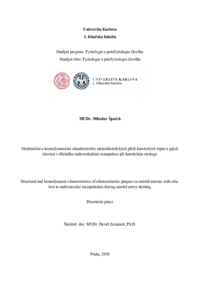Strukturální a hemodynamické charakteristiky aterosklerotických plátů karotických tepen a jejich chování v důsledku endovaskulární manipulace při karotickém stetingu.
Structural and hemodynamic characteristics of atherosclerotic plaques in carotid arteries with relation to endovascular manipulation during carotid artery stenting.
dizertační práce (OBHÁJENO)

Zobrazit/
Trvalý odkaz
http://hdl.handle.net/20.500.11956/107277Identifikátory
SIS: 183600
Katalog UK: 990022828380106986
Kolekce
- Kvalifikační práce [4870]
Autor
Vedoucí práce
Oponent práce
Malík, Jan
Pařenica, Jiří
Fakulta / součást
1. lékařská fakulta
Obor
-
Katedra / ústav / klinika
II. interní klinika - klinika kardiologie a angiologie 1. LF UK a VFN
Datum obhajoby
13. 6. 2019
Nakladatel
Univerzita Karlova, 1. lékařská fakultaJazyk
Čeština
Známka
Prospěl/a
Klíčová slova (česky)
Transkraniální doppler, karotický stenting, spektroskopie blízká infračervenému světlu, vulnerabilní plát, lipidové jádro, cerebrovaskulární rezerva, S-100B proteinKlíčová slova (anglicky)
Transcranial doppler, carotid artery stenting, near-infrared spectroscopy, vulnerable plaque, lipid core, cerebrovascular reserve, S-100B proteinIschemická cévní mozková příhoda (CMP) patří mezi nejčastější příčiny mortality, morbidi- ty a invalidity ve vyspělých zemích. Jednou z příčin ischemické CMP je aterosklerotické postižení karotických tepen. Karotická endarterektomie je efektivní metoda léčby těchto pacientů. Karotický stenting (CAS) je moderní alternativou chirurgické léčby a obě metody by měly být voleny v závis- losti na selekci pacientů. Přitom zejména CAS v posledních letech zaznamenává výrazný rozvoj, čemuž přispívají nové znalosti týkající se cerebrovaskulárního řečiště a složení aterosklerotických plátů. V naší práci jsme se zaměřili na pacienty indikované k CAS a pomocí dostupných metod jsme vyšetřovali charakteristiky a chování aterosklerotického plátu a zároveň hemodynamiky cereb- rovaskulárního řečiště, včetně vztahů k manipulaci s plátem v průběhu výkonu. Hlavní část práce zahrnuje pacienty vyšetřované transkraniální dopplerovskou ultrasonogra- fií umožňující hodnotit tok v hlavních nitrolebních tepnách a detekovat mikroembolizace během CAS. U vhodných kandidátů byla preprocedurálně vyšetřena cerebrovaskulární rezerva (CVR) po- mocí apnoického testu a zhodnocení toku v oftalmických tepnách. V případě procedury využívající k cerebrální ochraně dočasný jednostranný uzávěr karotického řečiště byly poté při CAS hodnoceny...
Atherosclerotic diseases including stroke are the leading causes of morbidity, mortality as well as disability in industrialized countries. Carotid endarterectomy was long considered the stan- dard approach for the treatment of atherosclerotic carotid disease, one of major causes of stroke. Over time, carotid artery stenting (CAS) has evolved as an alternative approach and is considered equivalent to surgical treatment in selected patients. Particularly in the last years, CAS has gained attention with the increasing knowledge regarding atherosclerotic plaque and cerebrovascular flow. In our study, we focused on patients undergoing CAS and evaluated structural and hemodynamic characteristics of atherosclerotic plaques together with relation to endovascular manipulation. The major part of the study includes transcranial doppler ultrasound evaluation which is able to detect flow in major cerebral arteries as well as to detect microembolizations of atherosclerotic particles during CAS. In eligible patients, we investigated the usefulness of cerebrovascular reserve (CVR) testing to predict severe hemodynamic changes in ipsilateral middle cerebral artery induced by temporary carotid occlusion during proximally protected CAS. CVR was tested by means of a breath-holding test and ophthalmic artery flow...
